Robert Whitbourne Remembers the Methodist Homes at Cheltenham
I was born in Collingwood in March 1932. I was the second youngest of four sisters and five brothers. Eighteen months to two years after I was born, my mother died. Arrangements were made for two of my brothers and my sister and me to be cared for at the Homes. As I was so young I really don’t remember going there.
My first recollections of the place was standing up in a cot and crying because my brother had been run over by the baker’s cart. Someone came to me and told me he had been run over. They didn’t tell me whether he was hurt. Fortunately he wasn’t, but I can still remember crying. I don’t really know what the baker’s cart was like but later on, it was a horse drawn cart so I think it must have been a horse drawn vehicle.
My other early memories of the Homes were: the school; play area; climbing roofs, trees and bird nesting. Later on, when I was older, I remember there was a lake out the back. It was great. There were yabbies and tadpoles in it, and an island in the middle which we could go out to. It was deep enough to swim in; it was waist deep, but for the kids it was not too deep. We used to make our own rafts. It was dirty muddy water. There were gum trees looking from Cato Cottage down to the pond, and behind the pond. They were tall gum trees, but no one ever climbed them because you couldn’t get up to the first branch.
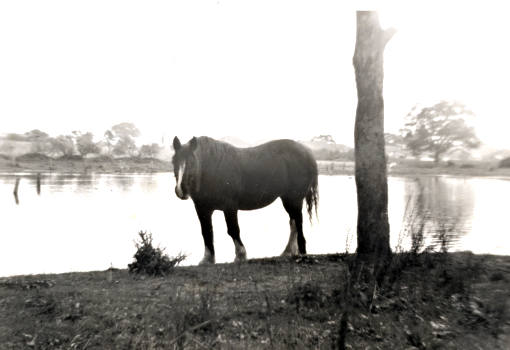
The lake taken from Tennyson Street looking towards Point Nepean Road.
We often climbed trees to raid the birds eggs in the nest I remember that once I got up on the school roof to get at a bird’s nest I don’t know why the bird’s nest was up there but we got them. We used to put them in our mouth and climb down. From Mrs. Whitehead’s room we could climb up on the fence to the cover of the porch area and up on the roof. You get the eggs in the ‘north and the south’, come down, hang on to the spout and drop down. I can remember this fellow saying ‘Are you all right, Whitbourne? We’ll catch you.” So I let go and landed with one foot on the roof and one foot on nothing. Ended up in Alfred Hospital. The eggs disappeared. I must have swallowed them. I can remember getting up from that and running around the baby school area and into the shelter shed. I ran round and round in the shelter shed and I could see a trail of blood in a circle where I was running. And then I woke up in hospital. I thought at first I may have broken a leg but it wasn’t that. The fall just knocked a bit of sense into me. The eggs we collected were mainly sparrow eggs. Why we collected them I’m not sure. We sometimes would blow the chooks eggs; put a hole in both ends and blow out the contents; but I can’t remember doing it with the sparrow eggs
Although I had others from my family with me, I fought with my brothers as much as with anyone else. However looking back I do believe they were my guardian angels but I didn’t realise it then. I can’t recall any visits from the other members of my family, but apparently they did. My father was a taxi driver and whilst in Cato House, on race days at Mentone1 and Epsom, I used to climb on the front fence, a cyclone fence with a steel top and sit on a pipe there and wave to him as he went past to the races. I often wondered why he never came and visited me but my sister said he did visit occasionally when I was younger.
When I first went to the Homes, I was in the infant cottage. It was simply called the babies section. It was on the first floor of the third building up from Jamieson Street. It was the old original two storey building. It was a room with lots of children there. The building had a big balcony which had wooden slats and cyclone type wire above, so that you could not climb over and fall down. In the early days there were problems with babies dying, but things changed after 1933, due to the acquisition of Cato Cottage. The next building was for the younger girls. There was a hedge alongside in which we often played. The first building was where we went to when we were older than babies. We went to the house at the southern end of the property where the accommodation was in rooms with five or six to a room. We had our meals in the main building, where the dining room was below the babies section and the kitchen alongside. The meals were good; always plenty to eat and we were never short of food.
We had our own school in the grounds of the Homes. The first room was for the babies (I went there at first). When I started school, I thought it was a fun thing. All the kids were together, and there were no hassles among them. We were all friends. The next room was the section for children up to Grade 4 which was looked after by Mrs. Whitehead. We all sat at small desks. Then there was a room up to Grade 8 with Mr. Roy Worthington as headmaster. We did our Merit Certificate in Grade 8. This classroom had rows of desks, with a big blackboard right in front. There were pathways, windows and flowers. I don’t know where they came from. The teacher’s table was the same level as the desks. The girls were in the same classes as us. During the day there was contact and during the weekends but generally there were no mixed activities.
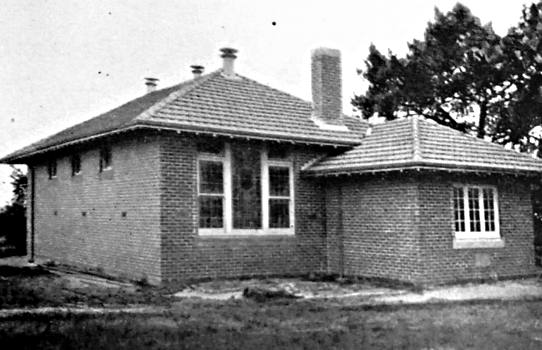
School at the Homes, c1919.
At play time we went to a play area behind where the babies were. There was a big brick yard there and also the shelter shed. As this was open on one side we would play there when it was wet. I can remember playing cricket there and doing a bit of tree climbing but not much football until we were older.
There was an exam to sit for the Merit Certificate. We did the exam at school. There was arithmetic, English Geography and all that. I can remember one particular question. It was a French question and I had no idea what the answer was and Mr. Worthington, the headmaster, was discussing things written on the blackboard. What was the meaning of that? My brother shouted out the answer, and he got a hiding for that, He got the strap. Mr Worthington changed the question. I knew the next question so that was great.
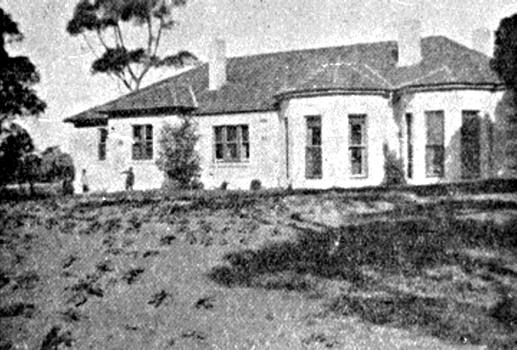
Cato Lodge.
At the age of eleven or twelve we went into Cato Cottage(Cato Cottage was set up to help train the young boys to work on farms). It was a big grey building. It looked as though the back part had been added later. Being there was good. Because it was only for senior boys (there were no girls) we had to do the all the work around the place including the dishes (on a roster system) polish the floor, make your bed, do everything. Someone came in to prepare our meals which were eaten at Cato. We didn’t go back to the dining room, but we did have to walk across to the school. We helped prepare the vegetables and peel potatoes in an old tram that was at the back of Cato. It was an old cable type tram, gold and brown and with golden trimmings. There was glass in the windows; we fixed that up. There were not many seats, they ran along the tram, not across. The floors at Cato were great because they had rubber matting, and plenty of it. We had to wax it and polish it off with what we called a buffer. It was a heavy block of wood with a handle of a broom with very short bristles on it and you would polish it off with that. Then you would put a rag to get a shine on it. To get an extra shine on it you would get a kid to sit on it and race up and down the passages with that. It worked out good in the end
There were six of us together in each room. Things were different at Cato from when you were in the main home area. Because we were not shut in, we were able to move around. Occasionally we went across the railway line to the sand pits. You could not do that in the main area. We had jobs to do, both before and after school. We had to milk the cows, feed the chooks, feed the pigs, and get the horse down. Mr. Gowrie was in charge. I am not sure if he was actually the supervisor, in fact we all thought he was the gardener. He was a great guy. He never gave me any trouble at all. As well as Mr. Gowrie, there was always a handyman on the site. Mr. Whelan was the last I remember; however they did change rather regularly. Mr. and Mrs. Letcher were there for some time. They were good people. I do not know of any other adults in the Cato area, although there were others in the main section of the Home. Nothing was slaughtered on the property. I don’t think not even the chooks; maybe a chook or two, but definitely no animals. I think the pigs were kept merely to get rid of the excess food.
All around the buildings the land was ploughed to grow vegetables for the Homes. Carrots, cabbage, silver beet, potatoes, almost everything. But not pumpkins. I remember we had a few pear trees; fruit trees and a passage way lined with almond trees. During the war, behind the school they built the air raid shelters. They were zig zag trenches in the ground. To me they were ten feet deep but probably would have been only five feet. We used to have a lot of fun in them until it rained and they got full of water. I don’t know how good they would have been in an air raid when all the kids got in them with all that water. We didn’t have to dig them. They weren’t lined as far as I know they were just earth.
Sometimes at night the senior boys would harness up the horse and cart and go down to the Cheltenham railway station to collect the donations of fruit and vegetables that were sent to the Homes. This was often three or four nights a week. The horse’s name was Tony, a black horse. He was a terrible horse. If in anyway he detected that you were a bit timid he would attack you and charge you, get up on his hind legs and come down on his front legs. But if you went straight up to him and grabbed him, you were right. I used to walk straight up to him, and being brave and stupid, I would give him a pat on his face, walk along the side of him and grab hold of his tail and thump him. I would hang on to his tail and we would race down to the stables at about a hundred mile an hour doing ten foot strides, but we got him down that way. But I remember one time he came down on my brother, on his front thigh, and he has had a bad leg ever since. The horse was used for general gardening at the Homes. Mr. Gowrie used him for ploughing and we would take him down to the Cheltenham Station to pick up the vegetables and other donations which had been sent from around Victoria to the Homes. He was the only horse we had. Every now and then, when he needed shodding, we had to take him to the farrier, somewhere in Bentleigh. It was a good job, because you got out of school all that day. We weren’t allowed to ride him to Bentleigh. You had to walk him there, but you could ride him back home. So it was an all day job.
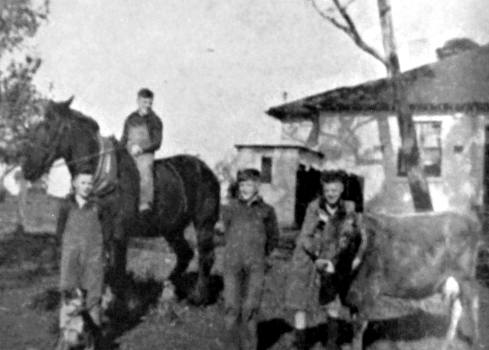
Boys from Cato Cottage.
We did things outside the Cato Cottage. I was in the scouts for about twelve months. Perhaps I shouldn’t mention scouts. We used to go to scouts at the Cheltenham Hall near the railway station. For some reason or other we all got turfed out. I do not know who the ring leaders were, but we all got into trouble and we were asked not to return.
On Sundays, we used to get dressed up and we would walk in twos to go to Church. We would be supervised going across Point Nepean Road to Charman Road and down to the Methodist Church in the morning. We would return to the Homes after Church, and go back in the afternoon for Sunday School, and occasionally we would go to the Sunday night service. I don’t remember much about Sunday School; it was a bit of a hassle. We would rather be playing in the yard than go to Sunday School. No one looked forward to going. I don’t think I created trouble although some may have done.
Even when we went to Church and Sunday School we felt we had to keep to ourselves and that we were not allowed to mix with the other kids. For myself, I never thought that I was different at any time in my life. The clothes that we wore on Sunday were different from our other clothes.
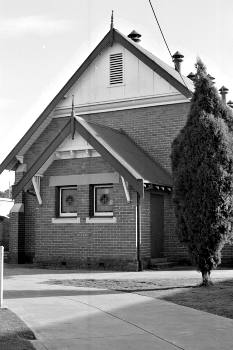
Methodist Church in Charman Road, Cheltenham. Courtesy Leader Collection.
There were times when I would run along Point Nepean Roads without having any shoes on. This was by my own choice. We were never short of shoes or socks or anything like that. I just preferred to run around in bare feet. We used to round up the cows in the freezing mornings, break the ice on the troughs so that they could have a drink, all in our bare feet. There was definitely never any shortage of clothing and food. To my knowledge there were never any problems in that way.
Occasionally we went to the Soldiers’ Hall where pictures were shown. Another thing we used to do was to go on a picnic somewhere every now and then. The furniture removalist man, Mr. Sloss used to come and get us. He would put long platform type of seats in the back there. I don’t know where we went. It appeared to be a long drive. But I can’t remember where we went, nor can I recall what I did.
Another thing I recall strongly. When I was about ten or eleven, they took us out on a Saturday afternoon which they did every now and then and we went to the Glaciarium Ice Skating Rink. I thought it was the greatest thing invented. When I eventually left the Home to go to Brisbane and came back to Melbourne when I was about seventeen or eighteen I made a bee line to that ice rink and I ended up in the speed skating team for Victoria. I really got into speed skating. It all started from that one visit from the Homes
To me, the school teachers were just normal people. They never gave me any trouble nor did I give them any trouble. I can’t remember reading many books. In my time at the Homes, I felt it was very good generally. You got the occasional belting but usually you deserved it and nobody resented it.
Weekends generally at the Homes were a good feature. I think it was in wintertime that we went away for the weekend. One boy went to a church family, and that was good. I can remember a couple of places. One was in Brighton. They had a little dog, and the dog didn’t like me or I didn’t like the dog. I don’t know what it was. When we sat at the table, the dog used to attack me from under the table. He got a terrible hiding for that. It was nothing to do with me and they didn’t hold that against me. Another one I went to was in Oakleigh. The lady sent me down to get a bottle of milk at a shop just a little way down the road. I went and got the bottle of milk and on the way back, I dropped it. I couldn’t put the bottle back together again and had to tell her the bottle was broken. It was the last time I went to that house. She didn’t want boys back! They were generally great weekends
Then came the time to leave the homes. I’m not sure when my sister left. My eldest brother from Brisbane came down with his newly married wife and asked whether my brother and I would like to live with them in Brisbane. He hadn’t been in the Home. I said it would be great. My brother in the Homes, George, said he would go too. That would be good as I would not be lonely. However, when the time came to go, he chickened out so when I left, he stayed at the Homes. I paid my own fare to Brisbane. I do not know how I got the money, however I had a pound left at the end of it all. This was my sole wealth.
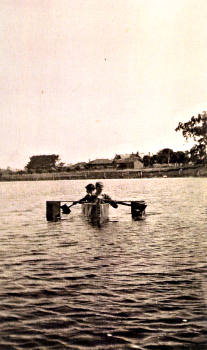
Methodist Homes Lake with rowers Ernie Peacock in front with Laurie Billings, 1938. Courtesy Reg Billings.
